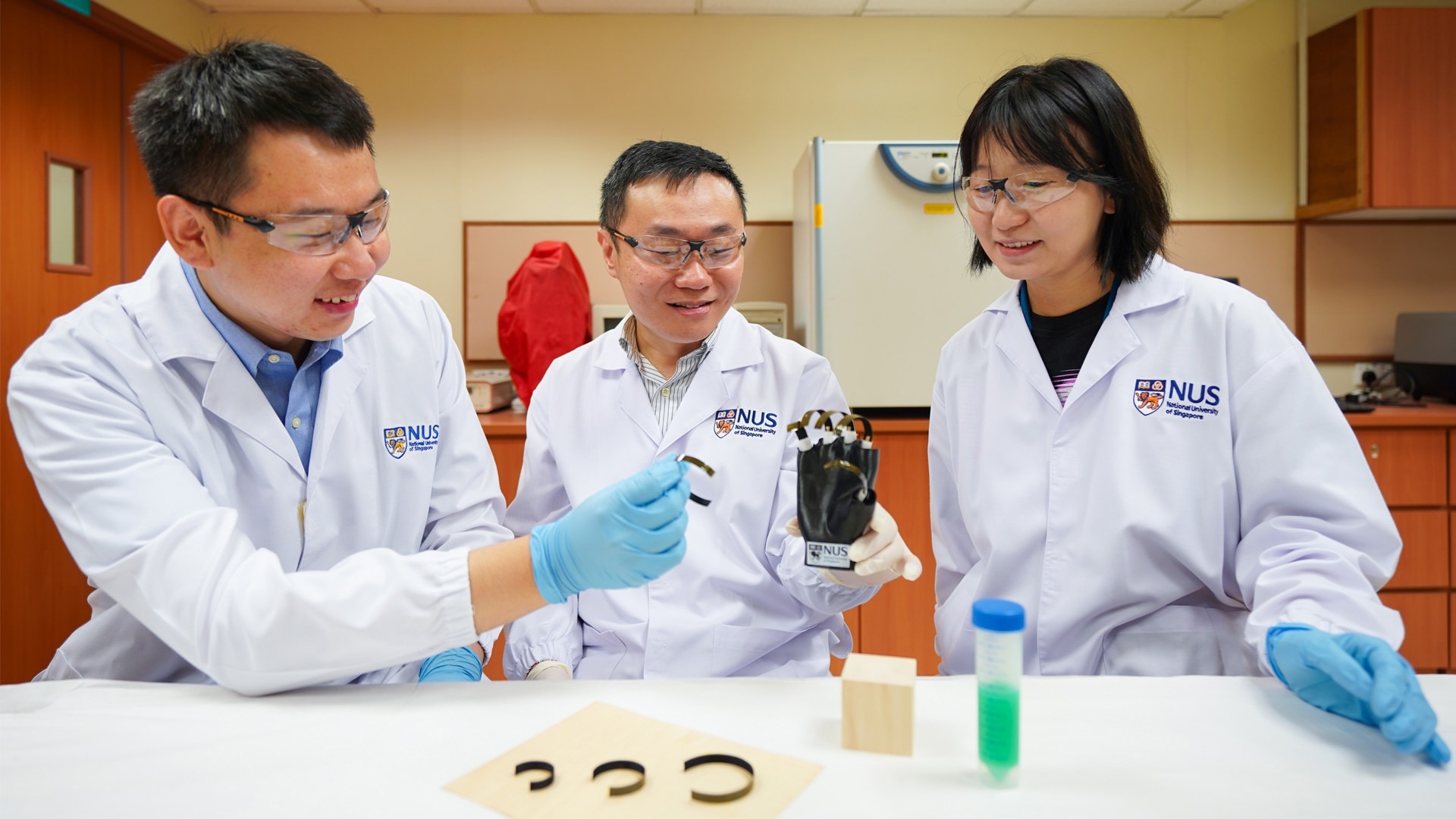The majority of robotic grippers are made utilizing either soft plastic to take objects without causing any harm to them, that melt at high temperatures, or metals that are firm and expensive.

Asst Prof Tan Swee Ching (center), together with team members Mr. Qu Hao (left) and Ms. Bai Lulu ((right), have developed a wooden gripper that is driven by changes in moisture, temperature, and lighting in the environment. Image Credit: National University of Singapore.
At the National University of Singapore (NUS), a research group, with their collaborators from the Northeast Forest University, have made a wooden robotic gripper that could be utilized in a very hot environment yet retain a tender touch.
Also, this groundbreaking wooden robotic gripper has another benefit–it is determined by changes in temperature, moisture, and lighting in the environment, hence reducing energy consumption.
Wood has excellent mechanical properties, natural deformation, available in large reserves, and is relatively cheap. In our latest work, we have shown that wood-based robotic grippers can overcome the limitations of traditional actuators and manipulators.
Tan Swee Ching, Study Lead Research and Assistant Professor, Department of Materials Science and Engineering, College of Design and Engineering, National University of Singapore
Ching added, “Our wooden robotic gripper can spontaneously stretch and bend itself in response to moisture, thermal and light stimulation. It also has good mechanical properties, able to perform complex deformation, wide working temperature range, low manufacturing cost, and is biocompatible. These unique features set it apart from conventional alternatives.”
The wooden gripper opens up when exposed to high humidity (more than 95% RH) and closes firmly when the temperature of the surroundings increases beyond 70 °C or when they have been exposed to solar radiation.
The research team published their invention in the online version of the scientific journal Advanced Materials on February 26th, 2023.
A Wooden Gripper That is Sensitive to Moisture, Thermal, and Light
The scientists made the wooden robotic gripper with the help of pieces of Canadian maple wood that are 0.5 mm thin. Initially, the pieces of wood were treated with sodium chloride to eliminate the lignin–a component found in the plant’s cell walls. The huge pores present in the wood have been filled with a polymer known as polypyrrole to allow the material to absorb heat and light more effortlessly.
Also, the research group formulated a new nickel-based hygroscopic gel for moisture absorption. One side of the altered wood pieces was covered with the moisture-absorbing gel. A hydrophobic film was fixed to the other side.
This wet-dry difference enables the wood rapidly absorb water vapors present on one side, and this expedites changes in the shape of the wooden gripper while being exposed to high humidity.
Further, the wood pieces were shaped into a gripper at 70 °C using unique molds. When positioned in an environment with 95% RH (that is, moisture stimulation), the hygroscopic gel took in moisture, and the wooden gripper stretched and slowly opened outwards.
When exposed to high ambient temperature of beyond 70 ºC (heat stimulation), the wooden gripper started to bend inwards and achieved maximum bending at 200 ºC.
Ms Bai Lulu, Study First Author and Doctoral Student, Department of Materials Science and Engineering, National University of Singapore
The wooden gripper was tested by the team under different light intensities, with the hydrophobic film layer confronting the light source. When the light illumination increased the temperature of the gripper’s surface to around 42 °C, the moisture-absorbing gel started to lose water. The gripper started to bend inwards before obtaining considerable bending at around 57 ºC.
Even after 100 actuating cycles, the wooden gripper remained intact, thereby illustrating its robustness and stability for long-lasting use.
Lifting Objects at High Temperatures
We also verified the performance of the wooden gripper by pick up objects at high temperatures. In our experiments, the wooden gripper successfully lifted a weight of 200 grams (equivalent to a can of soda) at around 170 deg C.
Chen Wenshuai, Study Co-Corresponding Author and Professor, Northeast Forest University
Wenshuai added, “This is impossible for most actuators made using soft polymer. Depending on the design, the wooden gripper could carry loads as high as 10,000 times the weight of the gripper.”
Next Steps
Currently, Assistant Professor Tan and his team are looking at enhancing the wooden gripper’s performance by lessening the bending time from around 2 minutes. This increased the weight load it could carry and also gripped objects of various shapes and sizes.
Also, they are finding methods to decrease the cost and scale up the fabrication of the wooden gripper.
With additional structural design and performance enhancement, the team believes in coming up with an improved version of the wooden gripper to assist firefighters in performing rescue operations.
Journal Reference
Bai, L., et al. (2023) Hygrothermic Wood Actuated Robotic Hand. Advanced Materials. doi.org/10.1002/adma.202211437.